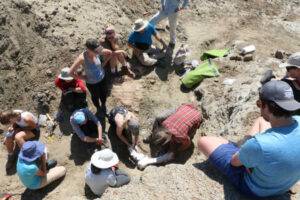
Paleontologists and students from McGill University have documented Saskatchewan’s first confirmed fossil specimens of Centrosaurus, a horned dinosaur species closely related to Triceratops.
The search, conducted in Saskatchewan Landing Provincial Park along the South Saskatchewan River, also unearthed a rare mix of dinosaur and marine fossils, shedding light on a dinosaur fauna that existed on the edge of an ancient sea at a time of rising sea levels long before humans roamed the earth.
The findings by biology professor Hans Larsson’s field team were published in the Canadian Journal of Earth Sciences. They shed new light on the habitat range of Centrosaurus and the unique Late Cretaceous coastal ecosystem of ancient Saskatchewan.
“We document the largest collection of fossil specimens assigned to Centrosaurus in Saskatchewan,” said Alexandre Demers-Potvin, corresponding author of the study who just defended his Ph.D. in the Department of Biology and wrote the paper for his thesis.
“It appeared to live near a shallow sea with several marine vertebrates, like sharks, which really confirms that the ancient range of this extinct species now extends all the way to the eastern coast of an ancient continent that included western North America.”
The discovery site, dubbed the Lake Diefenbaker Bonebed, reveals an environment unlike any previously documented in Canada. Approximately 75 million years ago, during the Late Cretaceous period, North America was divided by an inland sea. While Dinosaur Provincial Park in Alberta has long provided insight into inland ecosystems, this new site provides the first look at a coastal habitat, showing how large terrestrial dinosaurs like Centrosaurus shared space with marine animals in a mosaic of estuaries and barrier islands.
“Centrosaurus was only definitely known from sites of similar age in Alberta,” said Demers-Potvin. “Now we report fossils that unequivocally belong to this species from Saskatchewan for the first time. It was always very likely to be found nearby, but the presence of Citipes elegans, a small, parrot-beaked dinosaur, was more unexpected.”
The discovery of Citipes elegans, previously only known from Alberta, is the first of its kind in Saskatchewan and points to a broader diversity of small dinosaur species in the region.
“This entire ecosystem can help us understand how animals and plants adapted to that kind of environmental change without human interference and on a longer time scale,” said Larsson.
Most fossils in this study were excavated by McGill students participating in Larsson’s vertebrate paleontology field course. These fossils were prepared and curated at McGill’s Redpath Museum over the past decade on loan from the Royal Saskatchewan Museum in Regina.
Reference:
Alexandre V. Demers-Potvin et al, Occurrence of Centrosaurus apertus (Ceratopsidae: Centrosaurinae) in Saskatchewan, Canada, and expanded dinosaur diversity in the easternmost exposure of the Late Cretaceous (Campanian) Dinosaur Park Formation, Canadian Journal of Earth Sciences (2024). DOI: 10.1139/cjes-2023-0125
Note: The above post is reprinted from materials provided by McGill University.










